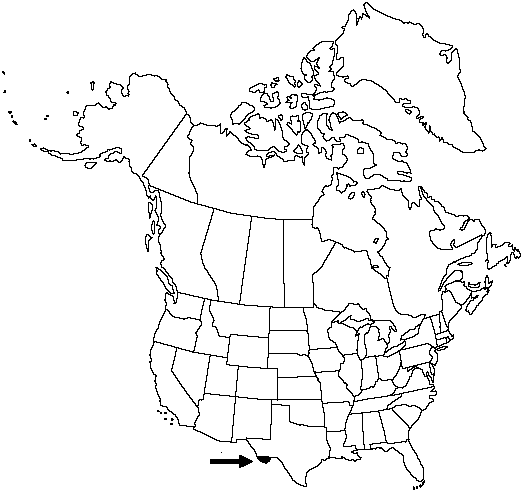Difference between revisions of "Notholaena aliena"
Contr. U.S. Natl. Herb. 17: 605. 1916.
FNA>Volume Importer |
FNA>Volume Importer |
||
| Line 19: | Line 19: | ||
}}<!-- | }}<!-- | ||
| − | --><span class="statement" id="st- | + | --><span class="statement" id="st-undefined" data-properties=""><b>Stem </b>scales concolored to weakly bicolored, margins usually brown, very narrow and poorly defined, thin, ciliate-denticulate. <b>Leaves</b> 5–15 cm. <b>Petiole</b> brown, equal to or shorter than blade, rounded adaxially, glandular-farinose, bearing scattered hairs and scales. <b>Blade</b> linear-lanceolate, 2-pinnate-pinnatifid, 3–6 times longer than wide, abaxially with conspicuous cream-colored or pale yellow farina and dull, light brown, narrowly lanceolate, ciliate scales scattered along rachises and costae, adaxially sparsely glandular and villous with long, multicelled, whitish hairs; basal pinnae equal to or slightly larger than adjacent pair, ± equilateral, proximal basiscopic pinnules not greatly enlarged. <b>Ultimate</b> segments sessile, broadly adnate to costae; segment margins slightly recurved, rarely concealing sporangia. <b>Sporangia</b> containing 16 spores.</span><!-- |
-->{{Treatment/Body | -->{{Treatment/Body | ||
| + | |phenology=Sporulating summer–fall. | ||
|habitat=Rocky slopes and cliffs, usually on volcanic substrates | |habitat=Rocky slopes and cliffs, usually on volcanic substrates | ||
|elevation=700–1200 m | |elevation=700–1200 m | ||
| Line 41: | Line 42: | ||
|basionyms= | |basionyms= | ||
|family=Pteridaceae | |family=Pteridaceae | ||
| + | |phenology=Sporulating summer–fall. | ||
|habitat=Rocky slopes and cliffs, usually on volcanic substrates | |habitat=Rocky slopes and cliffs, usually on volcanic substrates | ||
|elevation=700–1200 m | |elevation=700–1200 m | ||
| Line 48: | Line 50: | ||
|publication year=1916 | |publication year=1916 | ||
|special status= | |special status= | ||
| − | |source xml=https://jpend@bitbucket.org/aafc-mbb/fna- | + | |source xml=https://jpend@bitbucket.org/aafc-mbb/fna-data-curation.git/src/9216fc802291cd3df363fd52122300479582ede7/coarse_grained_fna_xml/V2/V2_429.xml |
|genus=Notholaena | |genus=Notholaena | ||
|species=Notholaena aliena | |species=Notholaena aliena | ||
| − | |||
| − | |||
| − | |||
| − | |||
| − | |||
| − | |||
| − | |||
| − | |||
| − | |||
| − | |||
| − | |||
| − | |||
| − | |||
| − | |||
| − | |||
| − | |||
| − | |||
| − | |||
| − | |||
| − | |||
| − | |||
| − | |||
| − | |||
| − | |||
| − | |||
| − | |||
| − | |||
| − | |||
| − | |||
| − | |||
| − | |||
| − | |||
| − | |||
| − | |||
| − | |||
}}<!-- | }}<!-- | ||
-->[[Category:Treatment]][[Category:Notholaena]] | -->[[Category:Treatment]][[Category:Notholaena]] | ||
Revision as of 13:20, 27 July 2019
Stem scales concolored to weakly bicolored, margins usually brown, very narrow and poorly defined, thin, ciliate-denticulate. Leaves 5–15 cm. Petiole brown, equal to or shorter than blade, rounded adaxially, glandular-farinose, bearing scattered hairs and scales. Blade linear-lanceolate, 2-pinnate-pinnatifid, 3–6 times longer than wide, abaxially with conspicuous cream-colored or pale yellow farina and dull, light brown, narrowly lanceolate, ciliate scales scattered along rachises and costae, adaxially sparsely glandular and villous with long, multicelled, whitish hairs; basal pinnae equal to or slightly larger than adjacent pair, ± equilateral, proximal basiscopic pinnules not greatly enlarged. Ultimate segments sessile, broadly adnate to costae; segment margins slightly recurved, rarely concealing sporangia. Sporangia containing 16 spores.
Phenology: Sporulating summer–fall.
Habitat: Rocky slopes and cliffs, usually on volcanic substrates
Elevation: 700–1200 m
Discussion
Notholaena aliena is a rare species closely related to N. grayi. Preliminary studies indicate that N. aliena reproduces by apogamy and is probably triploid.
Selected References
None.
